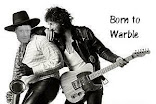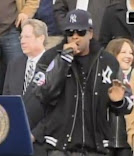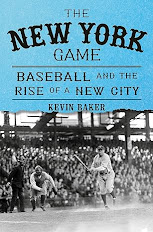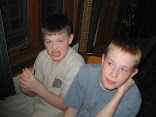Okay, great to see all the replies to the musical question, "Why did the Original Famous Ray's Yankees Dynasty Collapse?"
A couple of you said, "karma," due to all the beloved—or at least, incredibly successful—individuals the Yankees had decided to deep-six from 1960-66. These included no less than two, all-time broadcasting greats, Red Barber and Mel Allen—hey, the Yanks didn't want to pass up the chance to snag Joe Garagiola for the booth!—general manager George Weiss, and managers Casey Stengel and Yogi Berra— these last two moves meaning that the Yanks canned not one but two pennant-winning managers in the space of four years.
(Not to mention, men who had lost their last World Series' because of, respectively, a bad-hop grounder that hit a pebble, and an inexplicable series of errors by a Gold Glove second baseman.)
But hey, having divested themselves of that much institutional knowledge and baseball acumen...What could possibly go wrong???
The Yankees "braintrust" was now Ralph Houk, who as a GM was a pretty good field manager, and Johnny Keane, a man much too tightly wrapped for New York; one who never earned anything but contempt from his players and who would, sadly, expire from a ferocious cigarette habit in January, 1967—just months after being fired.But there is no karma in baseball!
What really brought about the collapse of The Greatest Dynasty What Ever Was, was injuries, general incompetence, and bad trades—both made and never made.
The injuries started fast and furious. Playing on a snow-swept field in freezing Bloomington, MN, on Opening Day, 1965, the Yankees lost BOTH ends of their starting battery.
Jim Bouton, winner of 39 games over the past two seasons, and Elston Howard, 1963 AL MVP and near Hall-of-Famer, both blew out their arms. Neither was anything more than a shell of their former selves again.
(This after the Yankees had seriously considered—but narrowly decided to pass on—trading Bouton for Frank Robinson, even up, in the offseason.)On and on it would soon go.
The Chairman of the Board, Whitey Ford, had one more excellent season in 1965. But he had already undergone extensive arm and nerve damage and—despite pitching very well when he could pitch—managed only 16 starts, combined, in 1966-67, and retired.
"The Milkshake Twins" were the next to go. Tony Kubek, an extremely talented ballplayer who could play any number of infield and outfield positions, never got over a back injury he had sustained while—of all things—playing touch football in the Army.He was finished at 29, and retired after the 1965 season.
His religious double-play partner, Bobby Richardson, decided to answer his calling to become a full-time minister back home in South Carolina, and retired after the 1966 season—at just 31.
Previously, the Yankees, like a shark with its teeth, always had replacements ready and waiting when unforeseen developments like these happened. And so it seemed that they had again.
But Tom Tresh, who had seemed like a budding superstar—Rookie of the Year in 1962 as a slugging shortstop, turned Gold Glove left fielder—tore up his knee in spring training, 1966, and that was essentially that. Though he stuck it out for a few more seasons, Tresh was never more than a shadow of his former self again.
Joe Pepitone, a Gold Glover at first, and another slugging, superstar-in-the-making there and in centerfield, succumbed to the assorted demons of mind and personality that made him first a farce, then a tragedy.
(Yogi Berra, much maligned as manager, had proved to be the one skipper able to keep Pepitone playing regularly and giving his all. But hey, Yogi was no Johnny Keane!)
The bad deals also came fast and furious. Bill Terry, rookie Deron Johnson, and Curt Blefary (basically a bum, but Rookie of the Year with Baltimore in 1965) were all given away for practically nothing.
Clete Boyer, the Gold Glove third baseman with some home run pop, was traded to Atlanta for Bill Robinson who—yet again—looked like a superstar-to-be to many scouts.Robinson would eventually make himself into a very good, starting outfielder. But he would do that, alas, in the National League, beginning around 1973.
Then, of course, there were the saddest stories of all.
Roger Maris was still just 30 in the spring of 1965, when he managed to injure his hand, after he and Boyer got into a fight with—I kid you not—a male model in a Florida bar.Maris never hit more than 13 home runs in a season again. A misdiagnosis of the injury by the Yanks' crack medical staff—some things never change—led to a terrible feud between, first, Maris and Ralph Houk, and then Maris and all Yankees fans.
After 1966, the Rajah was peddled off to St. Louis for third baseman Charlie Smith, to this day maybe the worst major-league player I have ever seen.
As for The Mick...well, the legs finally went on him in 1965, when he was still just 33. Incredibly, moved to first base, he still managed to put in three final seasons in which, hobbled though he was, he led the team in games played twice and made the AL top ten in many major hitting categories.
But by the time the smoke from all these crumbling Yankees monuments had cleared, the rules of the game had changed. With amateur and other drafts, the minors decimated by television, and the reserve clause still preventing easy player movement, rebuilding was a long, arduous process—one in which the Yanks' advantages in money, and especially in organization and baseball smarts, no longer applied.
The new owner at CBS, for whom the Yankees were an acquisition on a par with the purchases of the Fender guitar company and the road show for Hello, Dolly!, both of which the network had bought around the same time, could not have cared less.
So there you have it: an extraordinary number of unexpected injuries to brilliant players still in the prime of their careers, exacerbated by an incompetent training staff, poor field management, an incompetent front office, game-altering rule changes, a reduced minor leagues, and an indifferent, distracted owner with his eyes only on the bottom line.Huh. See any similarities there?



















































14 comments:
Horace, thanks for the great article(s). I wasn't a baseball fan in those years, grew up in Miami, and have only seen the "story" in dribs and drabs. When the injury bug really bites, even the wise are helpless. But bad trades.... wow!
Bouton for Frank Robinson. Wow. Never knew that. The alternate history just ripples out.
For example...
Ball Four would have had Boog Powell hiding under the stands and beaver shooting.
There's an image that can't be unseen.
Really well done posts. Thank you.
Yes, great work, Hoss.
I love everybody.
I just realized that Robinson was probably still on Cincinnati at the time of the proposed trade putting Pete Rose under the stands which, if you think about it, makes more sense but is equally disturbing.
Charlie Smith was not the worst Yankee player I ever saw.
To me, that was RICH McKinney brought over from the White Sox, to play 3rd, even though he never had done it before.
That was so bad, that I can't even bring myself to look up his stats in baseball-reference
Oh, yeah, and we traded Stan Bahnson for him, who only won 21 games for the w. sox that season
Great stuff from our very own historian. How many blogs can claim to have their very own historian?
But I believe the real reason for the Yankees decline in those years was the harmonica that belonged to Phil Linz who got Yogi fired and then was unceremoniously dumped on Phitin' Phils for Ruben Amaro.
Sad years, to be sure. Mary had a little lamb...
I hate to disagree with Hoss, as I read his posts and comments avidly and generally agree.
I was a kid taking the subway to the Bronx when all of this happened. It was inexpicable to me. In fact, it was mysterious.
But I see the answer NOW, from my now-so-freaking-wise vantagepoint, and it's pretty simple: They fired Yogi Berra.
Forget:
a. Yogi took the team to the 7th game of a World Series.
b. They fired him for.....what?
c. The hiring of Keane. That's just a bit of negative lagniappe.
The thing was: FIRING YOGI. It was unthinkable. It was untenable. They could have replaced him in the dugout with a combination of Jesus, Buddha, Allah, and the great numbers guy Robby Mook -- would not have mattered.
Just my opinion.
Thanks, guys!
I grant you, Archie, that Rich McKinney was pretty damned awful (though baseball reference said he had played some third before). Maybe the different was that the Yanks gave Charlie Smith an entire season and then some, while they got rid of McKinney after something like 35 games.
And let's not even bring up Jerry Kenney!
Joe FOB, firing Yogi was indeed inexcusable. The Yanks actually could have swept that Series, save for Richardson uncharacteristically making error after error, Whitey getting hurt, and an awful ump's call.
Trouble was, our Great Brain of 1964, Ralph Houk, had already decided to jettison Yogi over the Phil Linz incident, and the team languishing in August. He had already contacted Keane, and got him to agree to come over—about 35 ethics violations right there, secretly hiring a guy whose team you end up facing.
I really wonder what would have happened if the Yanks had won that Series. I doubt if they would have had the balls to can Yogi, but who knows? There is no getting around stupid.
"Richardson uncharacteristically making error after error,"
1917?
Now, if we can somehow get a harmonica into the hands of say, Hicks, or Gallo...
True, Doug K., he only made 2. But they were key. And it seemed, in the videos I've seen, like he was botching everything. A weird letdown by someone who was otherwise a pretty clutch player.
Just to say, it was hardly Yogi's fault. But they already wanted him gone.
A great postmortem of a once-great team of great players.
The M.E.'s report shows multiple organ failure, including the spleen and pituitary gland.
That organ failure did not, however, include Eddie Layton.
Post a Comment